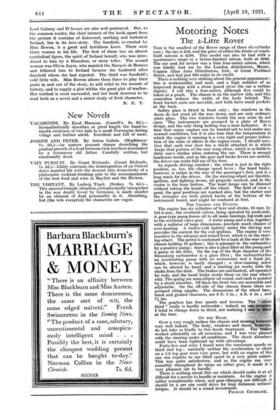Motoring Notes
The 2-Litre Rover THIS is the smallest of the Rover range of three six-cylinder cars ' • the tax is /16, 'and the price of either the fabric or coach- built saloons is £298. This model can also be had with a sportsman's coupe or a better-finished saloon, both at £348. The car sent for review was a blue four-seater saloon, which was kindly lent me by the London distributors, Messrs. Coppen Allan Auto Distributors, Ltd., of Great Portland Street, and had just 800 miles to its credit.
There is nothing very striking about the general appearance ; this is workmanlike and neat, and a high radiator of an improved design with a stone guard gives the car a certain dignity. I call this a four-seater, although five could be taken at a pinch. The chassis is on the narrow side, and this somewhat reduces the width of the body behind. The front bucket seats are movable, and both have small pockets at the back.
Safety glass is fitted in front only ; the windows in the
doors do not wind all the way down, and are only ordinary plate glass. The two windows beside the rear seats do not open. The instruments are grouped in a plate of Rover design, and the only thing lacking was a heat indicator. It is true that many engines can be trusted not to boil under any normal conditions, but it is also true that the temperature at which the engine is running is a very right and proper indica- tion of the state of affairs in the engine-room. I should men- tion that each rear door has a shield -attached to it which keeps that portion of the rear wing clean, which is so liable to dirty one's clothes when entering the car. There is enough headroom inside, and as the gear and brake levers are central, the driver can make full use of his door.
As regards driving comfort ; the wheel is just in the right
position, so, too, the change speed lever ; the hand brake, however, is rather in the way of the passenger's feet, and is a long reach for the driver. On the steering-wheel are throttle, ignition, and lighting levers, all properly marked, and in the centre is the horn button. The head lamps can be dimmed without taking the hands off the wheel. The field of view is good, the gear positions are marked also, but the starter and the strangler are both plated knobs at the bottom of the instrument board, and might be confused at first.














































 Previous page
Previous page